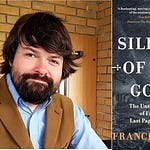For the first time ever, parents going through IVF can use whole genome sequencing to screen their embryos for hundreds of conditions. Harness the power of genetics to keep your family safe, with Orchid. Check them out at orchidhealth.com.
Today Razib talks to geneticist Erich Schwarz, a Research Professor in the Department of Molecular Biology and Genetics at Cornell University since 2012. Schwarz has a molecular biology degree from Harvard and a Ph.D. from Caltech. After working with the fruit fly Drosophila melanogaster in graduate school, he switched to the nematode Caenorhabditis elegans, and has continued studying nematodes ever since. After helping to found the C. elegans genome database WormBase (wormbase.org) in the early 2000s, he began sequencing and characterizing the genomes of several nematode worms other than C. elegans, either because they are biologically informative or because they are worldwide parasites. His current work includes using the genome of Ancylostoma ceylanicum to help devise an anti-hookworm vaccine.
Schwarz explains why C. elegans, often called “the worm,” has been so useful in developmental and molecular genetics, and its role in the career of the late Nobel laureate Sydney Brenner. With a simple anatomical structure, every single one of the 1,000 cells of C. elegans has been mapped and detailed. Despite its small size, this organism has spawned a research community of thousands, documented in Andrew Brown’s In the Beginning Was the Worm: Finding the Secrets of Life in a Tiny Hermaphrodite. In the age of hundreds of thousands of human genomes, Schwarz explains the decades-long period in the late 20th century when biological research was dominated by “model organisms,” simple and easy-to-experiment-on animals, plants and bacteria that could eloquently and plainly elucidate universal and essential mechanisms of function and structure.
Razib and Schwarz also discuss the future of model organisms in a genomic future, when high-throughput data analysis can supercharge decades-long experimental projects. Ultimately, the future is not likely to see model organisms set aside, but rather to witness them merged into the broader research community in human and medical genomics which has been driving technological changes in sppedspeed and volume of data collection.












